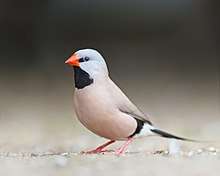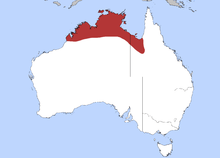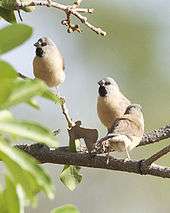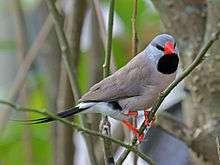Long-tailed finch
| Long-tailed finch | |
|---|---|
 | |
| Scientific classification | |
| Kingdom: | Animalia |
| Phylum: | Chordata |
| Class: | Aves |
| Order: | Passeriformes |
| Family: | Estrildidae |
| Genus: | Poephila |
| Species: | P. acuticauda |
| Binomial name | |
| Poephila acuticauda (Gould, 1840) | |
 | |
| Distribution | |
The long-tailed finch (Poephila acuticauda) is a common species of estrildid finch found in Australia; also known as the blackheart finch,[2] shaft-tail finch, Heck's grassfinch, Heck's grass finch, and Heck's finch. It is a predominantly fawn-coloured bird with a pale grey head and prominent black bib and eyes. It has an estimated global extent of occurrence of 1,000,000–10,000,000 km2. It inhabits dry savannah habitats in Australia and adapts readily to aviculture. The IUCN has classified the species as being of least concern.
Taxonomy
The long-tailed finch was first described by ornithologist John Gould in 1840 as Amadina acuticauda, having been collected by Benjamin Bynoe, the surgeon aboard HMS Beagle.[3] It is one of three species in the genus Poephila. It is placed in the Australo-papuan finch family Estrildidae, although this family itself was previously placed in the sparrow family Passeridae.[4]
A genetic study published in 2005 showed that the two subspecies of the long-tailed finch were separated from each other by the Kimberley Plateau–Arnhem Land Barrier around 340,000 years ago, and their ancestors diverged from the black-throated finch (P. cincta) across the Carpentarian Barrier 600 thousand years ago.[5]
Description

The adult long-tailed finch is around 15 cm (6 in) in length. It has a prominent roundish black bib on its throat and upper chest and a long pointed black tail.[6] It has pinkish brown upperparts with paler plumage below its bib over the lower breast and abdomen. It has a grey head, a white ear-patch, and black lores. It has black patches on its upper flanks and its rump and undertail coverts are white.[7] The beak colour of the adult long-tailed finch varies from red through orange to yellow. The subspecies with red beaks is sometimes called Heck's grass finch Poephila acuticauda hecki, and the nominate subspecies with orange or yellow beaks is sometimes called the long-tailed grass finch. Males and females are similar, except the females may be slightly duller and may have a slightly smaller bib.[8] Females have shorter wings and tails than males on average, but their measurements, as well as throat bib size, generally lie within the range of male measurements. Furthermore, male and female plumage is indistinguishable in ultraviolet and visible light. A study published in 1999 showed that male long-tailed finches were unable to determine the sex of unfamiliar members of their species unless the latter bird declared its sex by song.[9] Juveniles have black beaks and shorter tail feathers.[6]
Behaviour
The long-tailed finch inhabits open woodland across northern Australia, from Derby east to the Leichhardt River in northern Queensland.[7]
Male long-tailed finches approach unfamiliar members of the species and engage in a courtship display, holding themselves in an upright posture and singing, before attempting to mate with the newcomer. Male newcomers will sometimes not declare their sex when confronted by a group of birds. The authors of the study propose this is a survival mechanism to reduce harassment, increase chances of acceptance into the group and hence chances of future reproduction.[9]
The species breeds in natural hollows. Pairs share feeding responsibilities, and there has been one report of birds from older broods helping their parents raise the following brood, the first time that cooperative breeding has been recorded in an Australian estrildid finch.[10] The clutch consists of four to six dull white oval eggs measuring 17 x 12 mm.[11] The incubation period is 13 to 17 days.[2]
Aviculture

The long-tailed finch adapts readily to captivity, although it requires an aviary rather than a cage to thrive, and damp conditions need to be avoided.[2] Export of the species has been banned from Australia, and they have become rather expensive in the UK.[8] A caged pair are best kept on their own in the breeding season, because they become aggressive to other small finches.[8] They breed readily in captivity, sometimes producing two broods a year, and live for around 5 to 8 years. In captivity, a pair of Heck's grass finches (P. a. hecki) might raise brood after brood continuously, which would jeopardise their health, if they not are not fed with an adequate diet all year round.[8] Alternatively, the sexes can be separated for the winter.[8]
Origin
Origin and phylogeny has been obtained by Antonio Arnaiz-Villena et al.[12] Estrildinae may have originated in India and dispersed thereafter (towards Africa and Pacific Ocean habitats).
References
- ↑ BirdLife International (2012). "Poephila acuticauda". IUCN Red List of Threatened Species. Version 2013.2. International Union for Conservation of Nature. Retrieved 26 November 2013.
- 1 2 3 "Pet Road Tests: Long-tail Finch". Burke's Backyard. 2003. Retrieved 30 January 2011.
- ↑ Gould, John (2009) [1865]. Handbook to the Birds of Australia. BiblioBazaar. pp. 242–43. ISBN 1-116-37820-5. Retrieved 29 January 2011.
- ↑ Christidis L, Boles WE (2008). Systematics and Taxonomy of Australian Birds. Canberra: CSIRO Publishing. p. 177. ISBN 978-0-643-06511-6.
- ↑ Jennings, W. Bryan; Edwards, Scott V. (2005). "Speciational history of Australian grass finches ( Poephila ) inferred from 30 gene trees" (PDF). Evolution. 59 (9): 2033–47. doi:10.1554/05-280.1. PMID 16261740. Archived from the original (PDF) on 11 July 2010. Retrieved 29 January 2011.
- 1 2 Pizzey, Graham. "675 Long-tailed Finch". A Field Guide to the Birds of Australia. Illustrated by Doyle, Roy. Collins. p. 373. ISBN 0-00-217282-8.
- 1 2 Slater, Peter (1978) [1974]. A field guide to Australian birds: passerines. [Adelaide]: Rigby. p. 261. ISBN 0-85179-813-6.
- 1 2 3 4 5 Rutgers, A (1981). The Handbook of Foreign Birds. English translation by Norris, K.A. (4th ed.). Poole, Dorset: Blandford Press. pp. 167–168. ISBN 0-7137-0815-8.
- 1 2 Langmore, N.E., N. E.; Bennett, A.T.D. (1999). "Strategic Concealment of Sexual Identity in an Estrildid Finch". The Quarterly Review of Biology. Proceedings of the Royal Society B. 266 (1419): 543–50. doi:10.1098/rspb.1999.0670. PMC 1689814.
- ↑ van Rooij, Erica; Simon C. Griffith (2009). "First record of cooperative breeding in an Australian estrildid, the Long-tailed Finch (Poephila acuticauda)". Emu. 109 (1): 63–65. doi:10.1071/MU08061.
- ↑ Beruldsen, Gordon (2003). Australian Birds: Their Nests and Eggs. Kenmore Hills, Qld: self. p. 405. ISBN 0-646-42798-9.
- ↑ Arnaiz-Villena, A; Ruiz-del-Valle V; Gomez-Prieto P; Reguera R; Parga-Lozano C; Serrano-Vela I (2009). "Estrildinae Finches (Aves, Passeriformes) from Africa, South Asia and Australia: a Molecular Phylogeographic Study" (PDF). The Open Ornithology Journal. 2: 29–36. doi:10.2174/1874453200902010029. Archived from the original (PDF) on 2012-03-18.
External links
| Wikimedia Commons has media related to Poephila acuticauda. |
